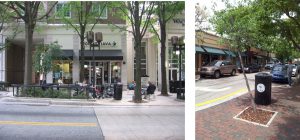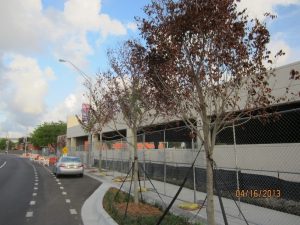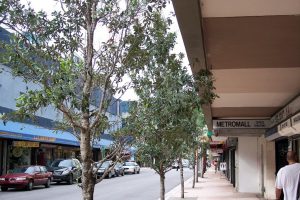How many times have you noticed that a tree just planted in the middle of a sidewalk is deteriorating? What is the average lifespan of a tree planted in a sidewalk? Does the tree have enough room to grow up and down? These questions are often not addressed, so the trees planted in a sidewalk eventually weaken and die.



In order for a tree to establish and grow, the soil, air and water requirements must be met. Since the soil provides the tree with support, as well as water, air and nutrients, the soil volume quantity and quality are critical. Different species of trees will require different soil volumes to reach maturity, but as a general guideline 1,000 ft3 (28 m3) of soil is a pretty good target to aim for. Another rule you can use is 2 cu. feet of soil per square foot of canopy (2 ft3 of soil / ft2 of canopy).

Unfortunately, not all areas can provide this type of soil volume for every tree. Budgets and site limitations are factors in the final decision. To overcome those limitations, a good landscape design is the foundation! Remember, small trees or palms in small spaces and medium size trees and palms in large places. It sounds very simple but how many times you have seen big trees like live oaks planted in a 4’x4’ sidewalk cutout with no root space?



A good strategy to overcome soil limitations is to plant trees that share corridors from tree wells to nearby volumes of soil like lawns and parks, or to use engineered hardscape solutions like suspended pavement, Silva cells, structural soil or others.

In any case, the minimum dimensions for cutouts in sidewalks to accommodate root flare on trees of various sizes are:
- large maturing trees – 8 x 8 feet
- medium sized trees – 6 x 6 feet
- small stature trees – 4 x 4 feet
And the minimum width of sidewalks are:
- large maturing trees – 9 feet
- medium sized trees – 7 feet
- small stature trees – 6 feet
Just following these recommendations, we can get much closer to getting our city’s trees what they need.
Literature Review
1.- Street Tree planting Standards – City of Berkeley
https://www.cityofberkeley.info/uploadedFiles/Parks_Rec_Waterfront/Level_3_-_Trees_and_Parks/City%20of%20Berkely%20Tree%20Planting%20Standards.pdf
2.- Sidewalk and hardscape solutions
https://hort.ifas.ufl.edu/woody/urban-sidewalk.shtml
3.-DeppRoot Green Infrastructure for your community
https://www.deeproot.com/blog/blog-entries/how-much-soil-do-you-need-to-grow-a-big-tree
- – Promoting root growth in sidewalk cutouts
https://hort.ifas.ufl.edu/woody/promoting-root.shtml
 1
1
